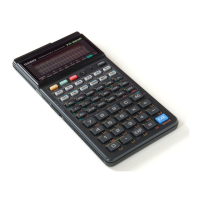
Do you have a question about the Casio FX-603P and is the answer not in the manual?
| Brand | Casio |
|---|---|
| Model | FX-603P |
| Category | Calculator |
| Language | English |
Crucial reminder to regularly back up data to prevent loss, especially after battery replacements.
Essential safety guidelines and warnings for operating the calculator to prevent damage or injury.
Instructions on how to replace the calculator's main and backup power supply batteries.
Explanation of the 'Low Battery!' message and its implications for calculator operation.
Details on the automatic power-off function that conserves battery life.
Guidance on using the contrast adjustment dial to optimize display readability.
Step-by-step guide for replacing the main power supply batteries, including precautions.
Instructions for replacing the backup power supply battery to maintain memory.
Explanation of the calculator's keys and their functions, including special keys and mode selection.
Description of the different operational modes available on the calculator (RUN, WRT, PCL, I/O).
Details on the calculator's display indicators, two-tier display, and exponential display features.
General overview of performing manual calculations, including register usage and key functions.
Steps and considerations before starting any calculation, including priority sequence and error handling.
Covers arithmetic operations, parentheses, constant calculations, and memory calculations.
Explanation of trigonometric, logarithmic, inverse, and other scientific functions.
Guide to performing calculations in different number systems and their conversions.
Instructions for performing standard deviation calculations and data input.
How to use the Alpha mode for character input and its applications.
Key terms and concepts necessary for understanding and performing program calculations.
Fundamental explanation of what a program is and its basic structure within the calculator.
Procedures for checking, correcting, adding, and deleting programs.
How to erase individual programs or all programs from the calculator's memory.
Steps to rename or reorder programs stored in the calculator.
Guidance on building programs, including strengths and weaknesses of different approaches.
Rules and conventions for writing and executing programs on the calculator.
Specific operations and display indications when writing programs.
Specific operations and display indications when executing programs.
How to use text strings for program comments and display during execution.
How to create, assign, and manage passwords for programs to protect them.
Steps to modify the password associated with a specific program number.
Explanation of flowchart symbols used to represent program logic and sequences.
How to use jump commands (GOTO, LBL) for program control and conditional execution.
Utilizing indirect addressing for registers and jump destinations in programs.
Introduction to basic programming concepts and examples.
Explanation of how the calculator finds jump destinations for GOTO and GSB commands.
How to save and load data, programs, and memory contents using peripherals.
Instructions for printing programs, memory contents, and display outputs.
Procedures for transferring programs and memory data between the calculator and other devices.
Overview of optional peripheral devices that can be connected to the calculator for expanded functionality.
Detailed steps for saving programs, memory, and display contents onto a cassette tape.
Instructions for saving programs and memory contents to a cassette tape.
Steps for saving only the memory contents to a cassette tape.
Procedure for saving only the text displayed on the screen to a cassette tape.
Procedure for loading programs from a cassette tape.
Steps for loading both programs and memory contents from a cassette tape.
Instructions for loading only memory contents from a cassette tape.
Procedure for loading only the text displayed on the screen from a cassette tape.
How to print programs, memory contents, and display contents using a printer.
Table of ASCII codes and their corresponding output substitutions for printing.
Steps to send program and memory data to a computer or another calculator via RS-232C.
Instructions for sending and receiving program data.
Instructions for sending and receiving combined program and memory data.
Instructions for sending and receiving only memory contents.
Instructions for sending and receiving memory contents.
Information on the compatibility of programs created on the FX-602P with this unit.
Overview of the features and capabilities of the FA-6 Interface Unit.
Details on connecting the cassette interface to the FA-6 unit and cassette recorder.
Information on connecting a Centronics printer to the FA-6 unit.
Specifications and connection details for the RS-232C interface.
Information about the FP-100 4-color plotter printer and its connection.
Details on the features of the FP-100 plotter printer.
Instructions for connecting the FP-100 plotter printer to the calculator.
Instructions for connecting the FP-40 character printer to the calculator.
Instructions for connecting the FP-40 character printer to the calculator.
Details on input ranges, calculations, accuracy, and remarks for calculator functions.
Input ranges, internal calculations, and accuracy for trigonometric and hyperbolic functions.
Input ranges, internal calculations, and accuracy for logarithmic and exponential functions.
Details on other functions like square root, powers, factorial, and logical operations.
Input ranges and conversion details for binary, octal, decimal, and hexadecimal numbers.
Explanation of input ranges and number conversions for Base-N systems.
General specifications of the calculator, including calculation types and display features.
General specifications of the calculator, including calculation types and display features.
Specifications related to program storage, jump commands, and program checking.
Details on display digits, character display, error checking, and power supply.
Information about the power supply, including battery types and consumption.
Details on the expected battery life for continuous program use and standby.
Information about the automatic power-off feature and its timing.
Specifies the operational temperature range for the calculator.
Physical dimensions of the calculator.
Weight of the calculator, including batteries.